Four-funnel liner
A four-funnel liner, also known as a four-stacker is an ocean liner with four funnels.
Kaiser Wilhelm der Grosse, launched in 1897, was the first ocean liner to have four funnels and was one of the first of the golden era of ocean liners that became prominent in the 20th century.[1]
Among the most well known four-funnels are Titanic, sunk on her maiden voyage on 15 April 1912, and Lusitania, torpedoed on 7 May 1915, during the First World War. In all, 15 four-funnel liners were produced; Great Eastern in 1858, and the remainder between 1897 and 1922. Four were sunk during the World Wars, and all others besides Titanic were scrapped.[2]
Mauretania was the fastest of all four-funnelled liners. The last four-funnelled liner ever built was Windsor Castle, however, two of her funnels were later removed making the Aquitania the last four-funnel liner in service and the only one to survive service during both World Wars.
Description
| Ship[2] | Line |
|---|---|
| Aquitania (1913) | Cunard |
| Arundel Castle (1919) | Union Castle |
| Britannic (1914) | White Star |
| Deutschland (1900) | Hamburg-Amerika |
| France (1910) | Compagnie Générale Transatlantique |
| Kaiser Wilhelm II (1902) | North German Lloyd |
| Kaiser Wilhelm der Grosse (1897) | North German Lloyd |
| Kronprinz Wilhelm (1901) | North German Lloyd |
| Kronprinzessin Cecilie (1906) | North German Lloyd |
| Lusitania (1906) | Cunard |
| Mauretania (1906) | Cunard |
| Olympic (1911) | White Star |
| Titanic (1912) | White Star |
| Windsor Castle (1922) | Union-Castle |
The primary purpose of funnels on steamships was to allow smoke, heat and excess steam to escape from the boiler rooms. As liners became larger, more boilers were used. The number of funnels became symbolic of speed and safety,[1] so shipping companies sometimes added false funnels—like the Olympic-class ocean liners—to give an impression of power.[3]
The trend of competing shipping lines building four-funnel liners encompassed a very short time span ranging from the SS Kaiser Wilhelm der Grosse in 1897 to the RMS Windsor Castle in 1922.

The Cunard Line record holders, Lusitania and Mauretania, were both laid out with four boiler rooms with one funnel to each room.
In keeping with the style and fashion of the early-20th century, the White Star Line opted to fit the three Olympic-class ships with a dummy fourth funnel to rival the two Cunard ships. The notion of four funnels representing size and power rapidly diminished soon after the First World War.
Proposed ships
The United States never operated any four-funnelled ocean liners in commercial service. However, in the late 1910s, William Francis Gibbs began to draft designs for new 1,000-foot liners that could reach a speed of 30 knots. Among the proposals was a pair of four-funnelled ships designed in 1919. The funnel and boiler arrangement would have been similar to the German four stackers, with the four funnels grouped in pairs with a wider gap between the second and third funnels. Possible names for the liners were the SS Boston and the SS Independence, but the ships never made it past the design phase.[4]
In the late 1920s the world's main shipping lines were Britain's Cunard Line and White Star Line and France's Compagnie Générale Transatlantique (CGT). Each of these three were operating ageing vessels and required new larger and more modern 1,000 feet (300 m) long superliners to remain competitive. CGT began construction of the SS Normandie while Cunard placed an order for the RMS Queen Mary.
White Star placed an order to their shipbuilders Harland and Wolff for Oceanic, a successor to the line's inaugural 1870-liner, RMS Oceanic. The exact intended design of Oceanic III is unknown, although company concept renderings show it to be a three-funnelled 1,000-foot (300 m) liner. However, early plans from Harland and Wolff's archives show a design from 1927 for a four-funnelled liner almost identical to the Olympic-class, except with a more-modern cruiser stern.[5]
With the onset of the Great Depression the shipping lines were crippled. The completion of Cunard's Queen Mary was delayed for four years and to raise the funds to complete her the British government gave Cunard a loan on the condition that Cunard merge with White Star into a single British shipping line.
References
- Ljungström, Henrik. "Kaiser Wilhelm der Grosse". The Great Ocean Liners. Archived from the original on 10 October 2009. Retrieved 8 September 2008.
- Pocock, Michael. "The Four-Funnel Liners". Retrieved 8 September 2008.
- "Titanic Station: Titanic's Funnels, or Smokestacks". Titanicstation.blogspot.com. 21 May 2007. Retrieved 5 July 2011.
- https://www.loc.gov/resource/sn78004456/1919-08-03/ed-1/?sp=7&r=0.03,0.804,0.901,0.538,0
- Harland and Wolff 1927 four-funnel liner plans http://titanichistoricalsociety.net/store/index.php?main_page=product_info&cPath=76&products_id=601
External links
 Media related to Four-funnel liners at Wikimedia Commons
Media related to Four-funnel liners at Wikimedia Commons
